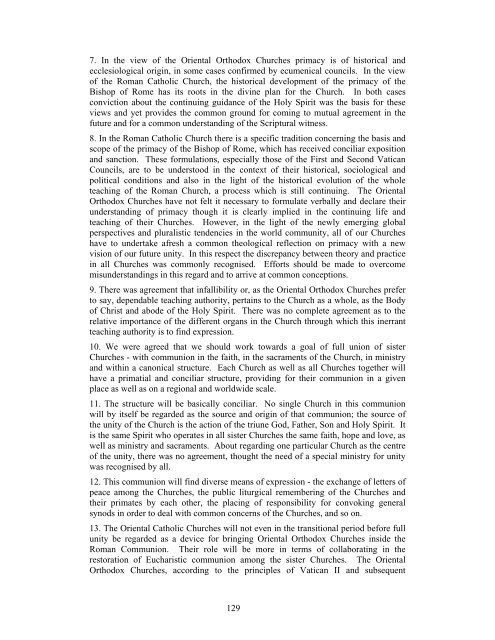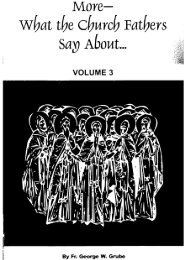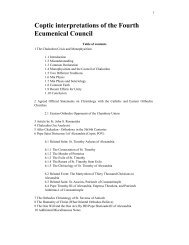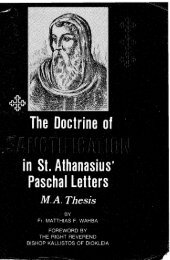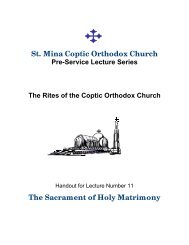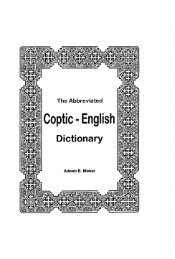Coptic Church & Ecumenical Movement - Saint Mina Coptic ...
Coptic Church & Ecumenical Movement - Saint Mina Coptic ...
Coptic Church & Ecumenical Movement - Saint Mina Coptic ...
You also want an ePaper? Increase the reach of your titles
YUMPU automatically turns print PDFs into web optimized ePapers that Google loves.
7. In the view of the Oriental Orthodox <strong>Church</strong>es primacy is of historical and<br />
ecclesiological origin, in some cases confirmed by ecumenical councils. In the view<br />
of the Roman Catholic <strong>Church</strong>, the historical development of the primacy of the<br />
Bishop of Rome has its roots in the divine plan for the <strong>Church</strong>. In both cases<br />
conviction about the continuing guidance of the Holy Spirit was the basis for these<br />
views and yet provides the common ground for coming to mutual agreement in the<br />
future and for a common understanding of the Scriptural witness.<br />
8. In the Roman Catholic <strong>Church</strong> there is a specific tradition concerning the basis and<br />
scope of the primacy of the Bishop of Rome, which has received conciliar exposition<br />
and sanction. These formulations, especially those of the First and Second Vatican<br />
Councils, are to be understood in the context of their historical, sociological and<br />
political conditions and also in the light of the historical evolution of the whole<br />
teaching of the Roman <strong>Church</strong>, a process which is still continuing. The Oriental<br />
Orthodox <strong>Church</strong>es have not felt it necessary to formulate verbally and declare their<br />
understanding of primacy though it is clearly implied in the continuing life and<br />
teaching of their <strong>Church</strong>es. However, in the light of the newly emerging global<br />
perspectives and pluralistic tendencies in the world community, all of our <strong>Church</strong>es<br />
have to undertake afresh a common theological reflection on primacy with a new<br />
vision of our future unity. In this respect the discrepancy between theory and practice<br />
in all <strong>Church</strong>es was commonly recognised. Efforts should be made to overcome<br />
misunderstandings in this regard and to arrive at common conceptions.<br />
9. There was agreement that infallibility or, as the Oriental Orthodox <strong>Church</strong>es prefer<br />
to say, dependable teaching authority, pertains to the <strong>Church</strong> as a whole, as the Body<br />
of Christ and abode of the Holy Spirit. There was no complete agreement as to the<br />
relative importance of the different organs in the <strong>Church</strong> through which this inerrant<br />
teaching authority is to find expression.<br />
10. We were agreed that we should work towards a goal of full union of sister<br />
<strong>Church</strong>es - with communion in the faith, in the sacraments of the <strong>Church</strong>, in ministry<br />
and within a canonical structure. Each <strong>Church</strong> as well as all <strong>Church</strong>es together will<br />
have a primatial and conciliar structure, providing for their communion in a given<br />
place as well as on a regional and worldwide scale.<br />
11. The structure will be basically conciliar. No single <strong>Church</strong> in this communion<br />
will by itself be regarded as the source and origin of that communion; the source of<br />
the unity of the <strong>Church</strong> is the action of the triune God, Father, Son and Holy Spirit. It<br />
is the same Spirit who operates in all sister <strong>Church</strong>es the same faith, hope and love, as<br />
well as ministry and sacraments. About regarding one particular <strong>Church</strong> as the centre<br />
of the unity, there was no agreement, thought the need of a special ministry for unity<br />
was recognised by all.<br />
12. This communion will find diverse means of expression - the exchange of letters of<br />
peace among the <strong>Church</strong>es, the public liturgical remembering of the <strong>Church</strong>es and<br />
their primates by each other, the placing of responsibility for convoking general<br />
synods in order to deal with common concerns of the <strong>Church</strong>es, and so on.<br />
13. The Oriental Catholic <strong>Church</strong>es will not even in the transitional period before full<br />
unity be regarded as a device for bringing Oriental Orthodox <strong>Church</strong>es inside the<br />
Roman Communion. Their role will be more in terms of collaborating in the<br />
restoration of Eucharistic communion among the sister <strong>Church</strong>es. The Oriental<br />
Orthodox <strong>Church</strong>es, according to the principles of Vatican II and subsequent<br />
129


